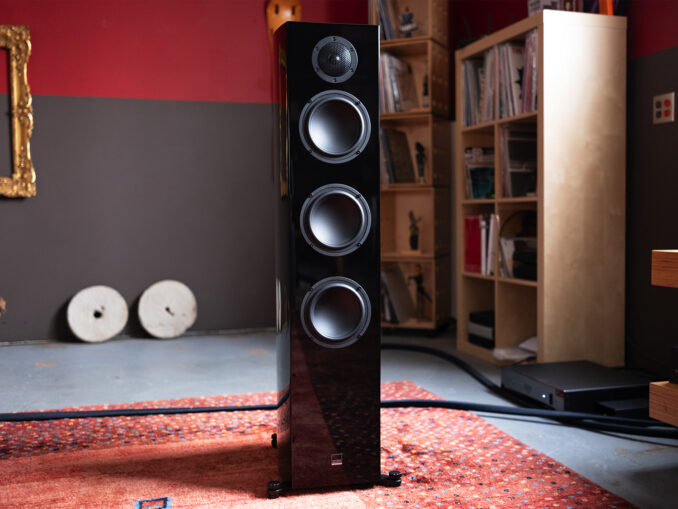
I’ll let you in on a little secret—while I have Favorites, within those favorites I have favorites.
I call these favorites within favorites The Short List, a list I share with Patrons, and the Capello 100 are on it because they do what I want a loudspeaker to do which is offer up music in a way that grabs and shakes me with surprise and delight, something the Capello 100 did each and every time I listened through them over their 2 month Barn stay.
I’ll share something else—I really don’t like breaking down speaker performance into frequency parts—bass, midrange, and treble—because these rather arbitrary and kinda nonsensical divisions give us the false belief that music is a) so simple, and b) so easily dissected when in reality music and the speakers that reproduce it are doing countless things. Countless things that are only fully communicated through listening. When writing about loudspeaker performance, we are necessarily providing a shorthand version of that experience even when offering up a more complete view than bass, mids, and highs.

Gauder Akustik was founded in 1997 by Dr. Roland Gauder and Achim Knapp and every pair of their speakers are manufactured in the company’s Renningen, Germany factory. The Gauder Akustik family of loudspeakers is comprised of five lines—Arcona, Capello, Elargo, Berlina, and DARC—25 speakers in all including stand mounts, floor standers, and center channels. The Capello 100 sit at the top of that line.
The Capello 100 are a 3-way/4 driver bass reflex design comprised of an upgraded aluminum tweeter (included in all USA models), Gauder Akustik aluminum-polymer XPulse drivers for the 7″ midrange and 2x 7″ bass drivers in a bottom-ported ‘drop’ shaped cabinet. The review pair, and every pair sold in the US, also come with Gauder Akustik’s Double Vision Gen II which adds “even more finely selected components from Mundorf, higher quality internal wiring, top quality WBT terminals and rhodium-plated bi-wiring bridges” as well as the Big Foot Spike Kit.
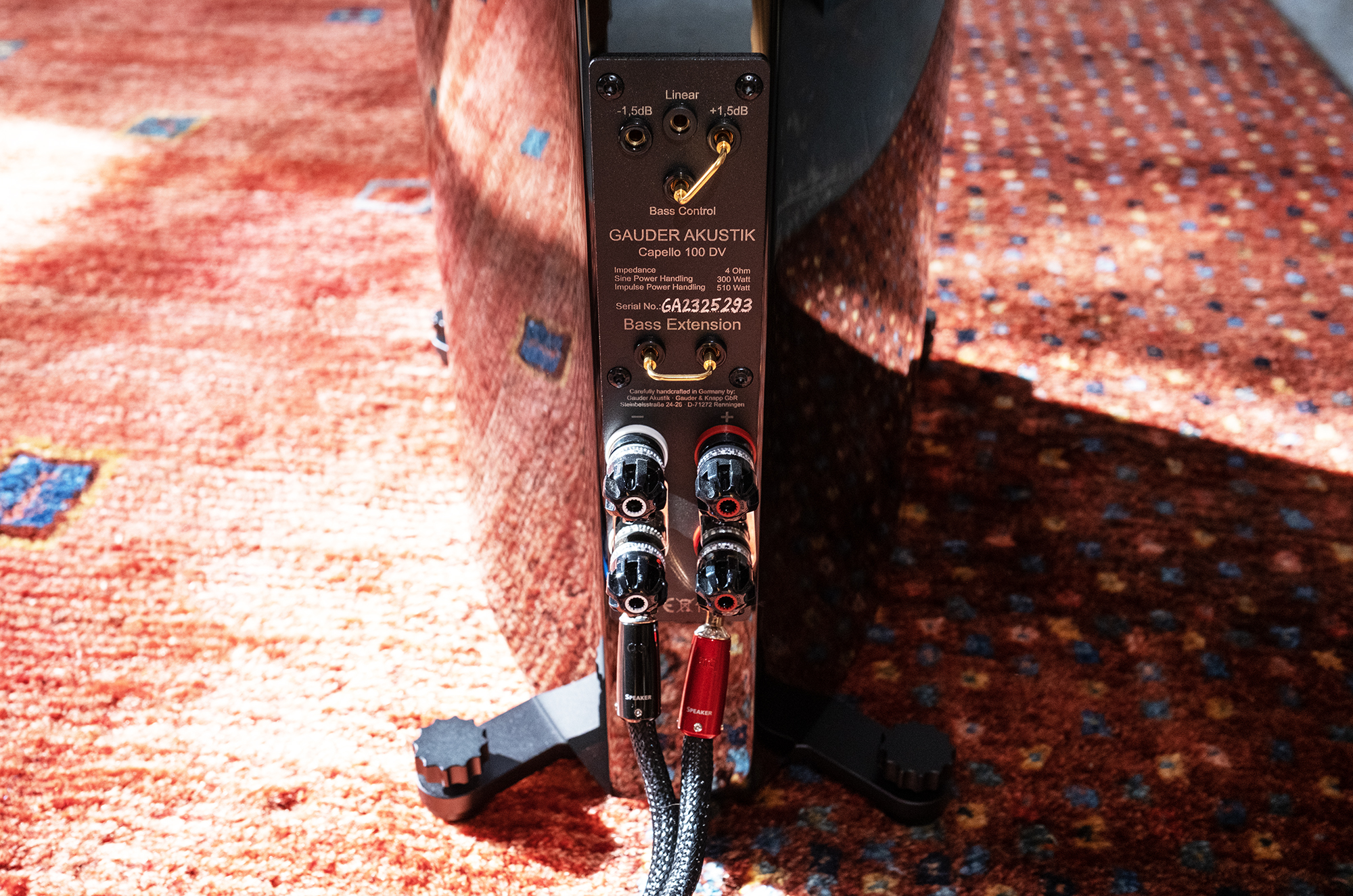
One of the Capello 100’s features that I found very useful and educational, I love when that happens, is the ability to fine tune their bass response to room, associated amp, and taste using the rear-mounted jumpers and the included Bass Extension Modules as follows:
No Jumper: 0 dB
Red Module: + 1 dB
Blue Module: + 2 dB
Green Module: + 3 dB
White Module: +3.5 dB
Jumper Plugged: + 4 dB
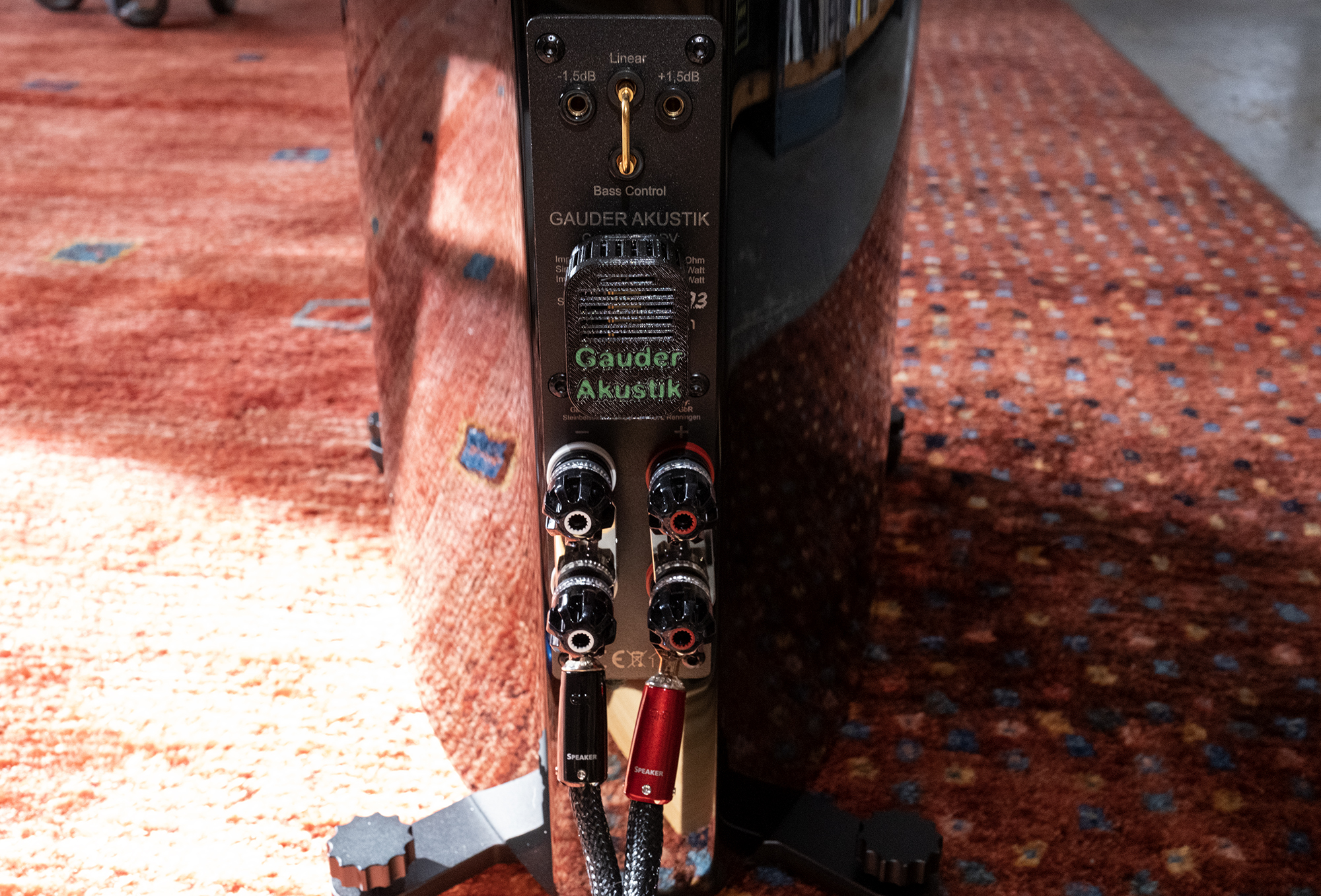
These modules simply plug into those Bass Extension slots.

The company provides more information on Bass Extension in the manual:
All our loudspeakers are highpass-filtered. This means that there is always a capacitor in the signal lead. A highpass-filtered closed-box or bassreflex system is of higher order than the usual systems and therefore have a better performance: they have a lower f3-point (lower bass enhanced), have a higher efficiency and need a smaller cabinet volume. Such systems use the amplifier as source of energy which for digital amps, transistor amps or big tube amps is not a problem. If you do not use such an amp to drive the speaker you can pull out the “Bass Extension Jumper” and deactivate the system (plugged jumper is 4 dB amplification). The impedance then rises up to 10 Ohms and more in the low-bass region and requires much less power from the amp.
Moreover, if you place the speakers close to a wall or in a corner then the low bass is also enhanced enormously. Reducing this low bass frequency range by pulling the Bass Extension jumper is also an appropriate way to reduce this problem easily.
I said educational because adjusting bass response using the jumpers and modules doesn’t just translate into simply more or less bass. Rather what these adjustments do is allow you to dial in bass that fuller, richer, deeper, and of perhaps even greater importance, tuneful rather than a one-tone blob.
This last quality meant that Devon Hoff’s double bass on “Go Your Way” featuring Sharon Van Etten on vocals from Hoff’s wonderful 2021 album Voices From the Empty Moor had tones and overtones that resounded with real world force in Barn as opposed to sounding like dull thuds, something I’ve heard in other rooms and systems. Hoff is a master at his instrument and he coaxes countless voices from it and with the bass dialed in on the Capello 100s I heard every one.
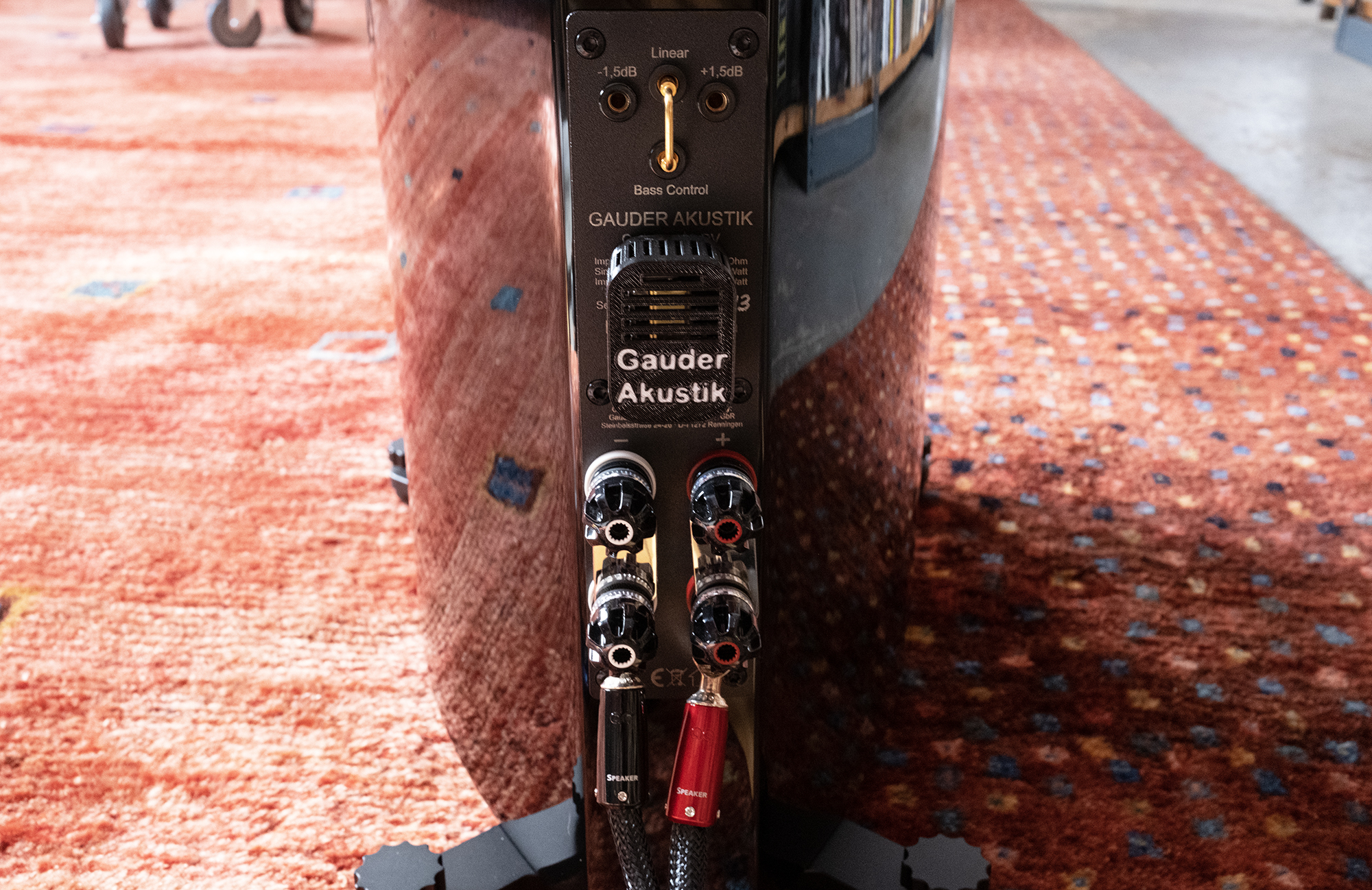
For my place and taste, I settled on the White Module’s +3.5 dB bump as it offered what I felt to be the best balance between level and quality. Head bangers and Jamaican Sound System lovers might feel differently. It’s also worth noting that I take real time positioning speakers in Barn, which I did with the Capello 100s that got to play on the Barn’s A- and B-Sides, but this extra bit of bass tweaking via jumpers and modules offered additional fine grained and effective control. Very, very nice.
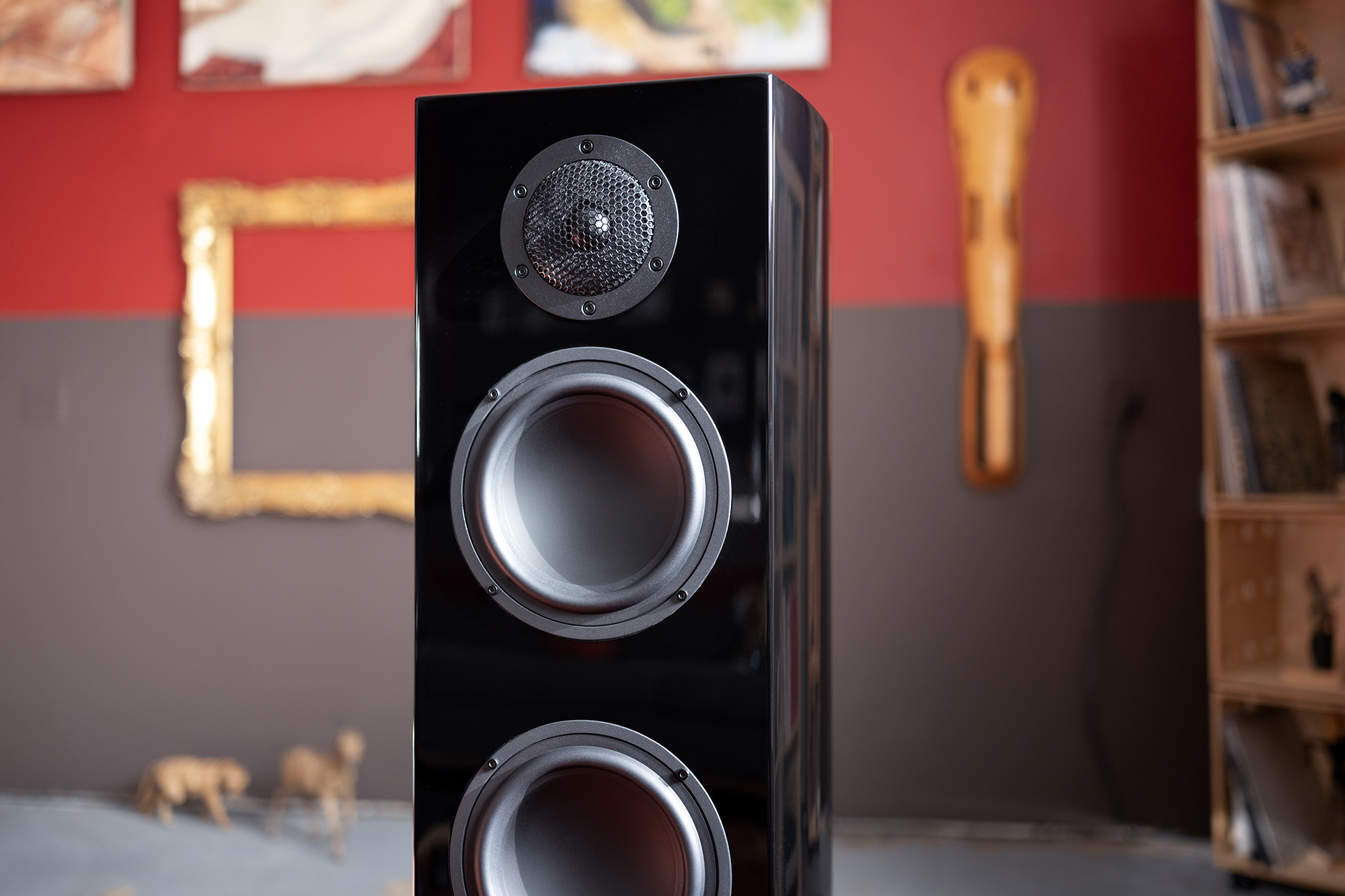
The review pair of Capello 100s are finished in a Black Piano high-gloss lacquer making them stealthier than a mirror and difficult to photograph. Other finishes include White Piano high-gloss lacquer and Olive or Walnut veneers. The Capello 100 have a claimed frequency response of 27-30,000 Hz with a 90dB sensitivity and 4 Ohm impedance, but as stated earlier their impedance will vary depending on which bass setting you choose. Two sets of WBT binding posts allow for bi-amping and bi-wiring. As I hope you can see from the photos, the Capello 100 are built to a very high standard.
Here are some technical highlights from Gauder Akustik:
- acoustically favorable drop shaped cabinet
- GAUDER Akustik XPulse drivers
- Aluminum tweeter
- Ultra-slanted, balanced crossover networks
- TDC Time Delay Control integrated
- exclusively components from Mundorf, IT and WBT
- Bass Extension System, customizable with modules
- Adjustable bass level
- WBT BiWiring terminals
- Clearwater internal wiring
- Adjustable spikes in the spike bars
- Front-grille available
I encourage you to take a long look at the Gauder Akustik website as they dig into some detail behind these technologies including their Time Delay Control. Here’s a snippet from the website:
As our speakers all have very low crossover frequencies from the bass to the midrange (120 Hz – 166 Hz) and the ear is very insensitive in the bass range, there is no need for a time delay between the midrange and the bass. In addition, instruments in this frequency range naturally resonate much more slowly than the time difference generated by the coils.
Thanks to the uninterrupted reproduction with TDC, there is no longer any distortion even in the acoustic phase of the loudspeaker and the music detaches itself wonderfully from the loudspeaker and plays from “wall to wall” in the listening room – resulting in a perfect illusion of spatial sound.
The TDC technology in combination with our ultra-steep crossover filters creates perfect impulse reproduction for the first time in hi-fi history and can absolutely be described as a game changer.
I also recommend a read-through of the Gauder Akustik manual as it contains very useful information such as this (with my emphasis):
In principle, one can state that a good amplifier should have a powerful power supply and a high damping factor. The damping factor describes the ratio bet- ween the impedance of the speaker (e.g. 8 Ohms) and the output impedance of the amplifier (e.g. 0.08 Ohms). For our example the damping factor equals 100 which is a quite reasonable value. The higher the damping factor the better is the control of the amplifier over the speaker’s own behaviour.
A well-designed power supply allows high current stability resulting in a dynamic, uncompressed reproduction.
But damping factor and current stability are only two of a hundred sound relevant criteria.
Therefore we refer you to your local dealer who will present you suitable electronics to your gauder akustik loudspeakers.
It’s worth noting that all of the loudspeakers from Gauder Akustik, no matter the line, share the same technologies including high pass filtering, Bass Extension, TDC, and symmetrical crossovers, while cabinet construction is the main difference as you move up the lines. This allows for a consistent “family character” of sound according to the company.
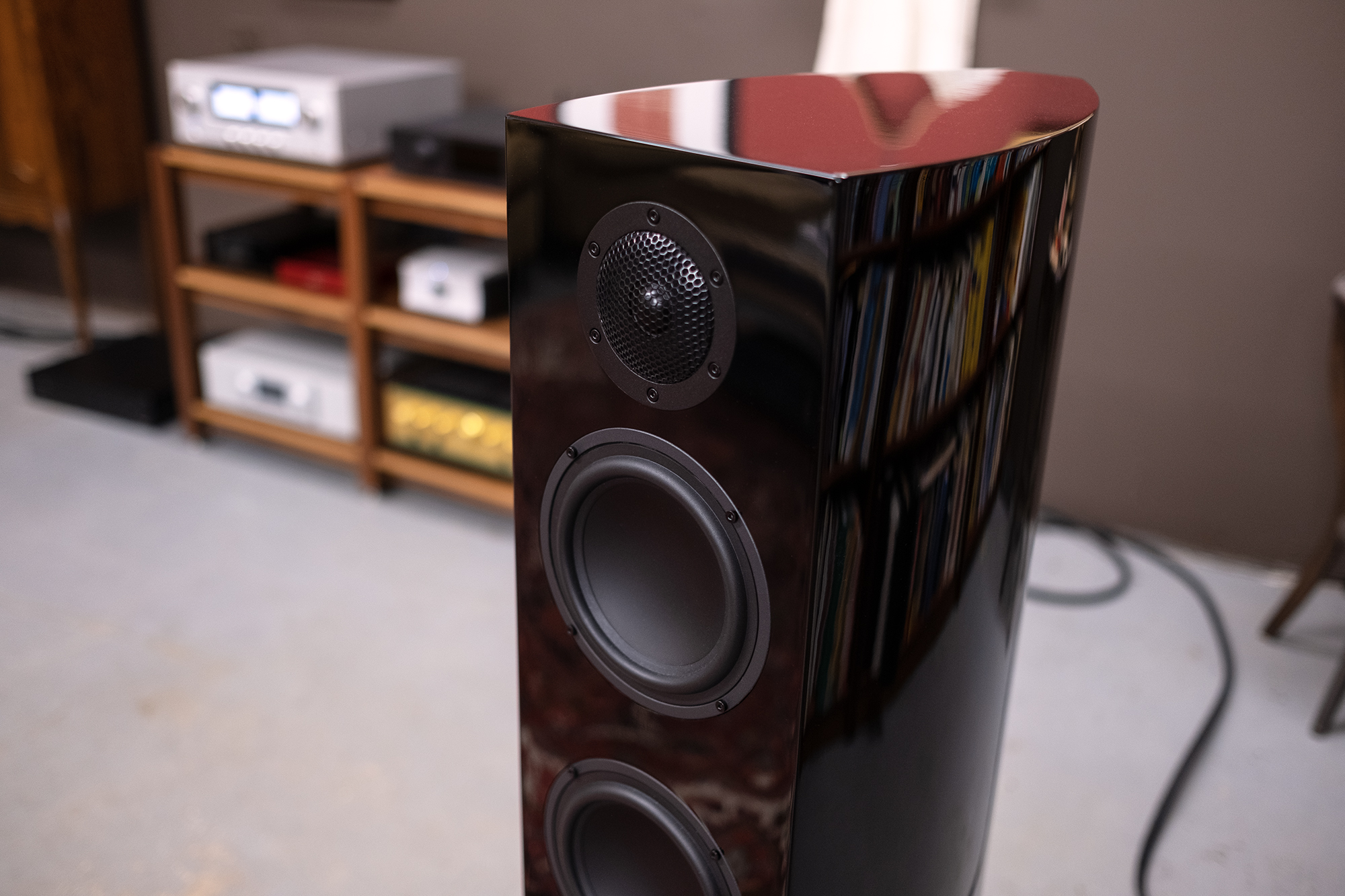
The Capello 100 got to spend time with the recently reviewed Luxman L-505Z Integrated (review), the review Pathos InPol Heritage MKII Integrated (more info), and the OK-I’m-gonna-say-it stunning Soulution 331 Integrated (more info). The Barn resident Grimm MU1 (review)/totaldac d1-unity (review) combo on the A-Side and the review Aurender A1000 (more info) took care of streaming and D-to-A’ing with cabling from AudioQuest all around (see full Barn and system details).
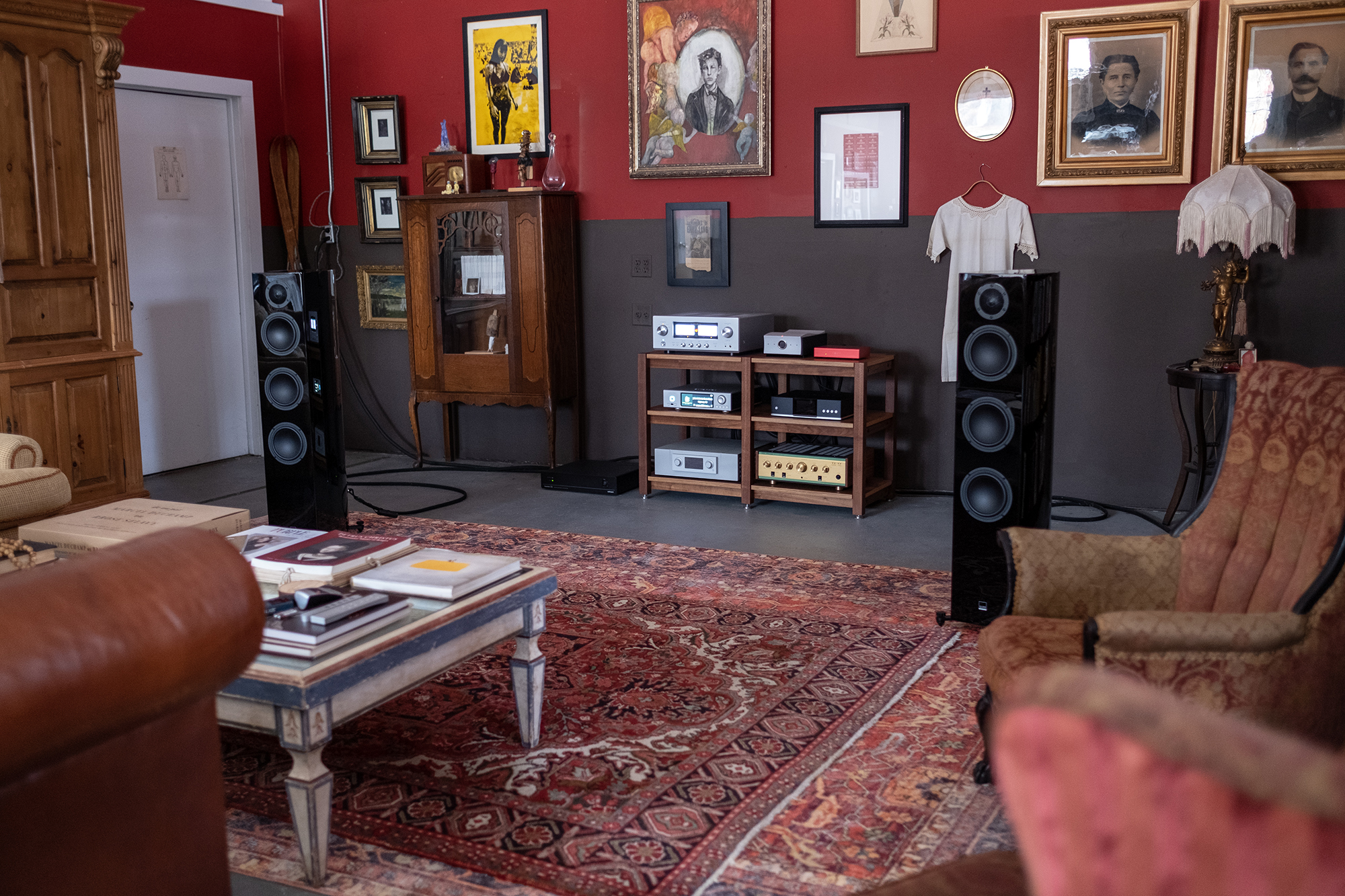
The Capello 100 began their Barn time on the B-Side with the Luxman/Aurender system and once I had them properly placed I relaxed into the comfy couch and was immediately struck by these speaker’s rather uncanny dynamic snap that felt at once more powerful and more focused than I’m accustomed to. I’d call this aspect of the Capello 100’s performance rather extraordinary and it made music that much more exciting and startling where the music called for it. Very, very nice.
Santa Cruz, CA-based Scowl have released two singles from their forthcoming sophomore album Are We All Angels and they are real barn burners. Hyper-driven and anger laden, “Not Hell, Not Heaven” and “Special” pulse with pure hardcore energy, the kind of hard hitting adrenaline-junky music that the Capello 100’s eat up and spit out with live-like force.
From Stereogum:
“It’s about feeling victimized and being a victim, but not wanting to identify with being a victim,” Kat Moss explains about the fiery tune. “It’s trying to find grace in the fact that I have my power. I live in my reality. You have to deal with whatever you’re dealing with, and it ain’t working for me.”
Singer Kat Moss, guitarists Malachi Greene and Mikey Bifolco, bassist Bailey Lupo, and drummer Cole Gilbert travel at heart racing speed pounding out power chunks of sound that the Capello 100 offered up with breakneck dynamics and manic energy all the while sounding fully in control and with help from the Pathos InPol amp, Grimm/totaldac system rich tuneful speaker-free impact. The Capello 100’s ability to project the origin of drum kit, chunky crunchy guitar, and screamed vocals in space with real impact is a quality that let music run free from system confines, throwing out blazing hot controlled energy around the Barn. Stunning. And while I’m not a fan of ascribing specific aspects of performance to specific aspects of speaker design, I have to believe the Capello 100’s aluminum-polymer diaphragms as found in the XPulse drivers go some way is explaining this stiff yet nuanced sound.
As you might expect, these same standout qualities made percussion-heavy music joyfully delightful. Holy Tongue meets Shackleton’s 2024 release The Tumbling Psychic Joy of Now is one such specimen, with a tropical rain forest’s worth of sounds from Italo-British drummer Valentina Magaletti, electronic music producer Al Wootton, and Susumu Mukai on bass and percussion joined by electronic wizard Shackleton. This is psychedelic stuff turned kaleidoscopic room filling rainbows of sound thanks to the Capello 100’s ability to reproduce a sound image as large as the recording allows while rendering every thwack, snap, and pop with live-like realism and impact. This, coupled with a richness and rightness in timbre made for an impressive display of you-are-there realism in reproduction.
I know what some of you are thinking—what about female vocals, jazz, and large scale classical? I know as well as the next guy that we audiophiles can be reductive to the point of ridiculous and does anyone really believe anyone could fall in love with a speaker that only excels at jazz? Hell, you could have a lineup of piano, bass, and drums that’s nowhere near jazz but obviously offers the same sonic challenges. Which kinda brings me to the Tara Clerkin Trio’s supremely lovely EP In Spring from 2021. Piano, horns, strings, vocals and other electronic things are delicately interwoven, sounding like the aural equivalent of the sun’s rays bouncing off water and here, with the Soulution 331 in charge, every last ounce of nuance from this chamber-pop-jazz beauty shone through. Delicacy, timbre, and timing hold sway on In Spring and the Capello 100 proved to be elegant dancers with the kind of just right mix of saturation and dexterity that transforms reproduced music into living energy in room that in this case moved and grooved well beyond the confines of the box.
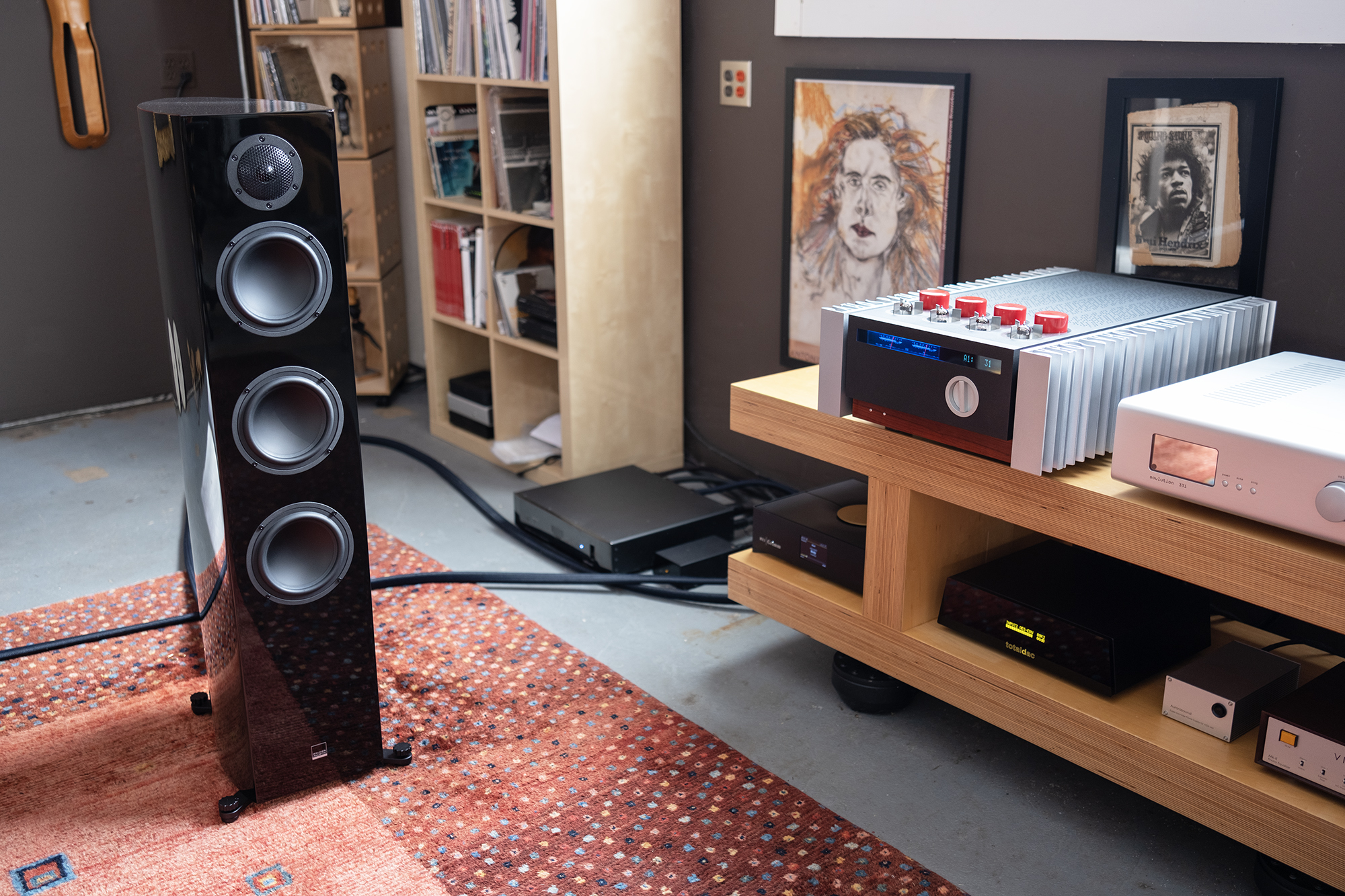
Side note: I’ve heard people say things like “I can’t listen to box speakers” and have to wonder if they’ve ever heard good ones properly set up, especially when singing the praises of open baffle speakers that can spray sound all around like an unmanned fire hose with water flowing at full tilt.
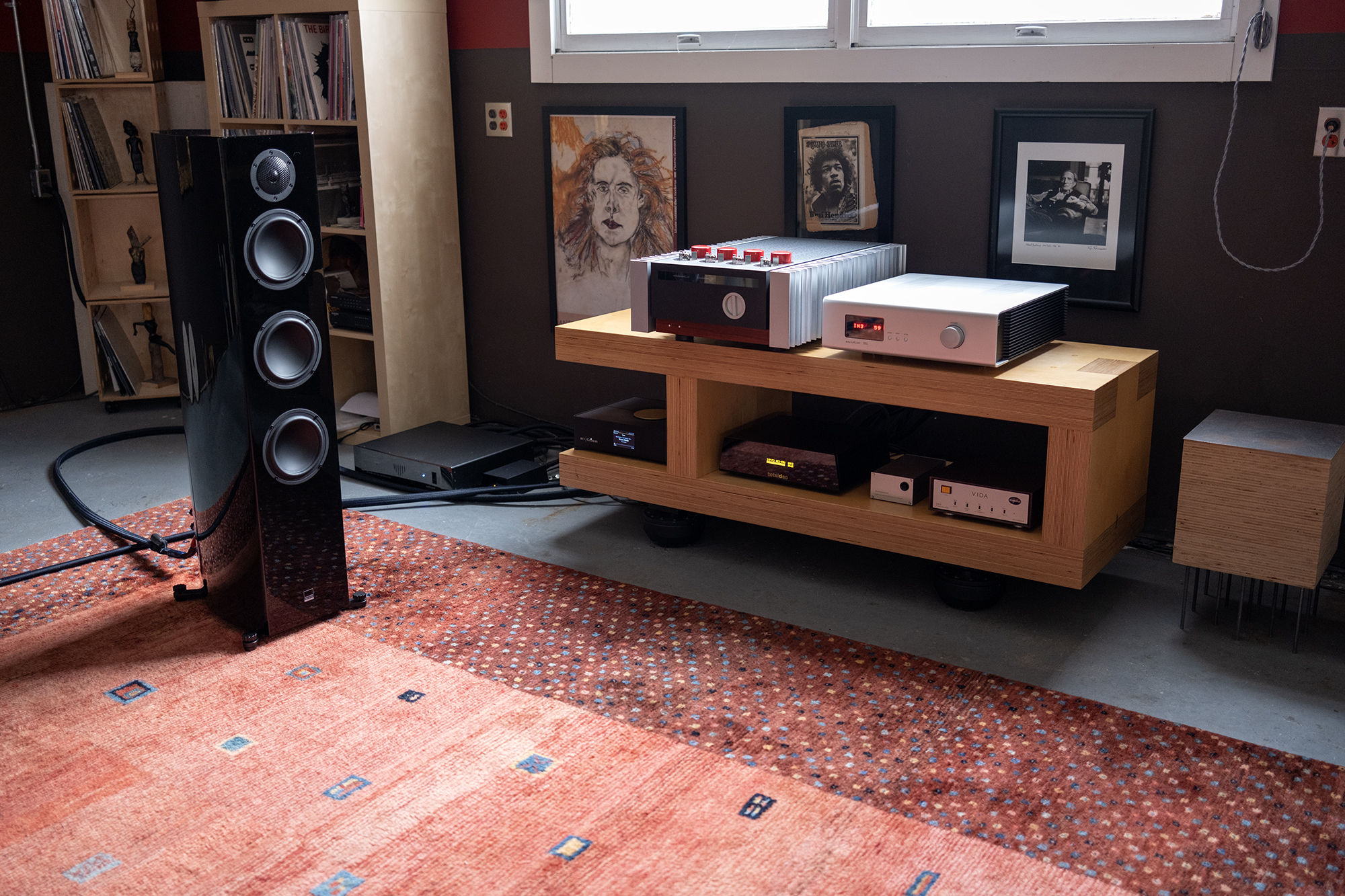
The Capello 100 come in, price wise, in the same ballpark as the recently reviewed Canton Reference 2 (review) as well as the Volti Audio Rival Special Edition (review), and Zu Definition 6 (review) which all sit on my Favorite Speakers list. But getting back to favorites among favorites, for my tastes and desires the Gauder Akustik are more engaging, more exciting, and more accomplished than these other fine speakers. While each of these other favorites have standout qualities in their own right, the Capello 100 stand out from the bunch by being exceptionally well balanced to the point where their overall performance is their stand out quality. I would say something very similar about the Rockport Atria II (review) which offer even greater levels of performance and therefore even deeper engagement albeit at a higher cost ($38,000/pair).
In go big or go home fashion, let’s talk about Krystian Zimerman’s take on Beethoven with the London Symphony Orchestra and conductor Sir Simon Rattle. Sweet purity, oh sweet purity came to mind as Zimerman’s piano sang out in Barn with that just right combination of touch and tone, delicacy and power with the full backing band, OK symphony, twirling, swirling, with bombastic bravado. The Capello 100 can play as loud as your ears can safely go and this grand music nearly transformed the Barn and me into a grand palais kinda affair. Can you be grand while wearing Carharrt? In any event, kettle drums rattled the Barn’s rattly bits and strings swayed under Zimerman’s stunning mastery. I could have danced all night.
I feel the need, every 3rd or 4th review or so, to remind readers that the few musical selections highlighted here are the tip of a very large iceberg of music that filled and thrilled the Barn and me for the past 2 or so months. I’m going to paraphrase and twist Duke Ellington’s famous quote to share that I only like 2 kinds of music—good music & the other kind—and everyone from Ethel Cain, Current 93, Jeff Parker, Debussy, Throbbing Gristle, Keiji Heino, MJ Lederman, Led Zeppelin, and Porridge Radio took turns lighting the place, and me, up and higher still.
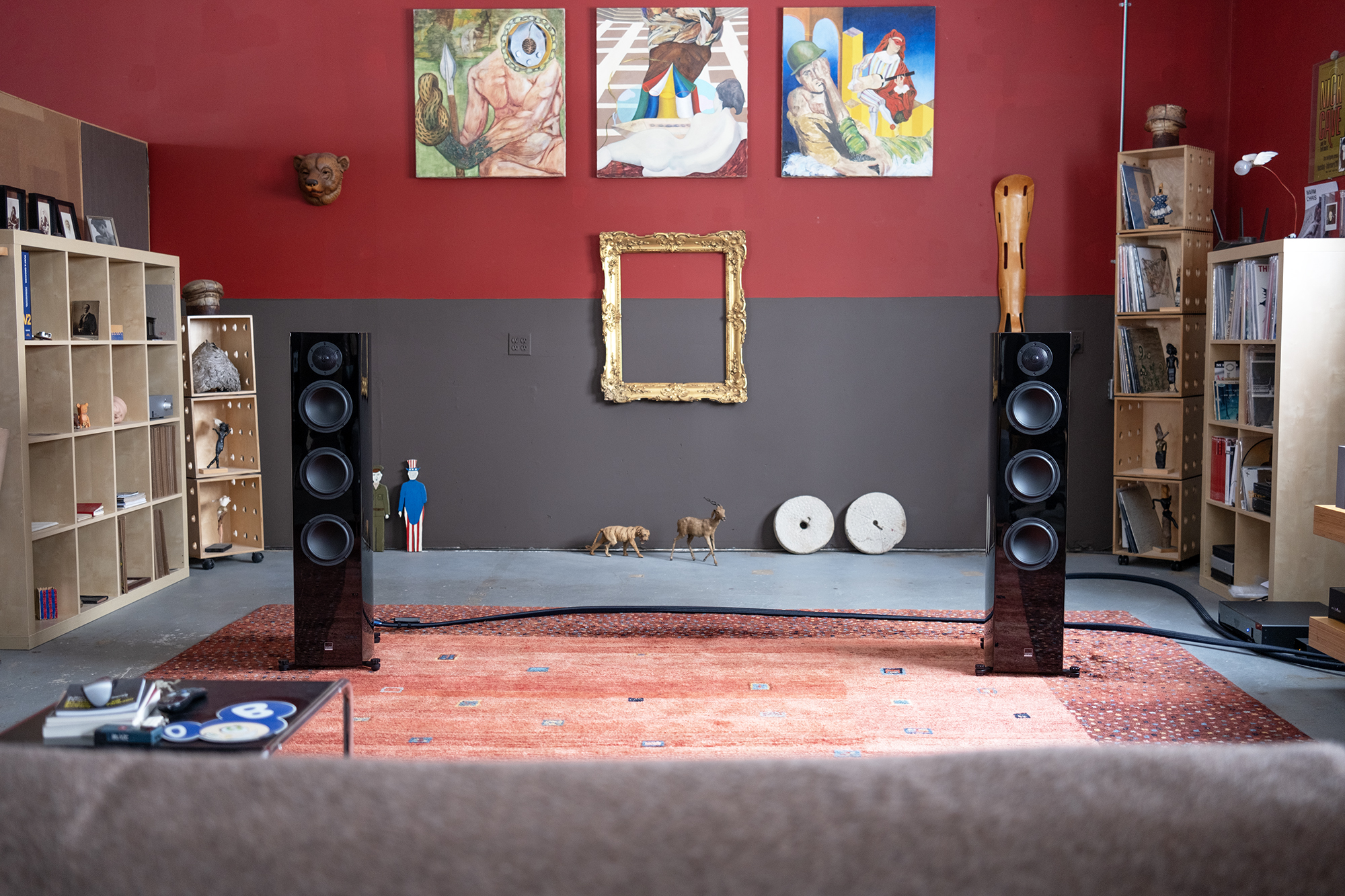
The Gauder Akustik Capello 100s moved onto my short list of favorites within favorites soon after their arrival. The more time spent listening and loving everything I heard from and through them make the Capello 100s essential entries on the must hear list for anyone with the requisite budget looking for that last pair of speakers.
Gauder Akustik Capello 100 Loudspeakers
Price: $26,975/pair
Company Website: Gauder Akustik
US Distributor: AXISS Audio
Capello 100 Specifications
Construction: 3-way bass reflex loudspeaker
Frequency response: 27-30,000 Hz
Efficiency: 90 db
Impedance: 4 Ohm
Recommended minimum amp power: 35 watts
Sine Power Handling: 300 watts
Impulse Power Handling: 500 watts
Crossover Points: 144/3400
Height: 114
Width: 25
Depth: 42
Weight: 28

